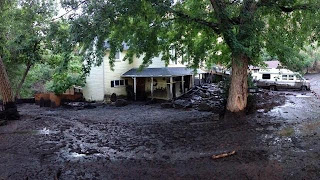Published by The Gazette | January 28, 2013 | Written by R. Scott Rappold
 |
| Trees Need Water All Year |
Drought — you can see it everywhere.
From the bare hills of the Waldo Canyon burn scar to half-full reservoirs to the mostly snowless face of Pikes Peak, there’s no denying this winter is shaping up to be even worse than last year.
As of last week, mountain snowpack was at 62 percent of average and Colorado Springs had received less than half its normal winter precipitation. Forget about your lawn. Experts say, in such times, people need to act to save their trees from what one local company called the “horticultural cliff.”
“Winter watering right now is just critical,” city forester Paul Smith said. “Boy, when we get those 50-degree days, people should drag that hose out and let it run slow on their trees.”
* * *
Myth: Colorado Springs is a natural environment for our many trees.
Fact: The city was a tree-less prairie when founded in 1872.
* * *
The Pikes Peak region has been in and out of drought for more than a decade, which has led the city to remove hundreds of dead or dying trees from medians and rights-of-way.
“We always live in a drought area,” Smith said. “We’re a semi-arid to an arid high plains desert, so we’re always in a water deficit.”
Still, the elm, spruce, oak and other trees that have been planted over the years usually can survive, if not thrive, in this climate.
But when stressed by persistent drought, they become vulnerable to pests and disease.
Smith said ips beetles have been killing spruce and ponderosa pine at a higher-than-normal rate. Scale insects have been killing older elm trees. While the mountain pine beetle that has decimated the northern part of Colorado isn’t here in great numbers, other insects such as weevils are. There is also the threat of disease, such as Dutch elm disease and pine wilt, which attacks Austrian and Scotch pine.
* * *
Myth: Trees go dormant in winter and don’t need water.
Fact: While the tree’s functions slow, it does not shut down.
* * *
“Think of yourself sleeping at night. You’re not burning a lot of calories. You are still burning some calories because those internal functions are still happening,” said Barbara Bates, El Paso County horticulture agent for the Colorado State University Cooperative Extension. “Trees are still burning some sugars. They’re still doing respiration. They’re still doing maintenance.”
That’s why she said at least once a month, when the temperature is in the 40s or 50s and the ground isn’t frozen, people should water their trees.
Pines should be the highest priority because they stay more active in winter, as well as trees on south- and west-facing slopes that receive more sunshine. And the time to do it is now, to help the trees produce more and healthier buds in the spring.
“If you can do some preventative watering and try to keep those trees out of the stress zone, you’re saving yourself money in the long run and that’s the best thing you can do to try to ensure the survival of the tree,” Bates said.
* * *
Myth: You should water the trunk of a tree.
Fact: Watering is most effective at the “drip line,” the edge of the canopy.
* * *
When you’ve dragged out the garden hose on a warm winter day, Bates suggests finding a way to water slowly, to ensure that more water sinks into the cold ground. Use a low sprinkler setting or pour from a bucket with holes in the bottom.
Around the tree’s canopy, drop enough that each area gets at least 2 inches of water.
In city parks and medians, crews use water trucks to irrigate trees whenever the temperature is high enough. But trees in the rights-of-way along streets are the responsibility of residents to water.
But watering might not be enough, especially if the dry winter becomes a dry spring.
“The typical customary March and April, you get some decent heavy, wet snow. That’s the bulk of the moisture, our snowiest months,” said Tony Hahn, landscape care consultant with Swingle Lawn, Tree & Landscape Care, “Last April we didn’t get it. And last March we didn’t get it.”
By June, the city was parched and the foothills were a tinderbox, a perfect storm for the outbreak of the Waldo Canyon fire, the most destructive in Colorado history.
As spring arrives and insects get more active, he said residents should keep a close eye on conifers such as spruce and Austrian and ponderosa pine, especially if they are on a south- or west-facing slope. Signs of poor tree health include slow growth, change in needle colors, needles dropping and small, nonproducing buds.
Holes in bark, sawdust, yellow or red spots and the presence of woodpeckers are indications of insects. Older, larger trees are most susceptible, Hahn said.
Concerned tree owners can hire a company to spray preventively or after-the-fact for insects, at a cost of about $70 for two trees and $8-$15 per additional tree, Hahn said.
Bates, the horticulture agent, was asked how worried she is for the health of Colorado Springs’ trees.
On a scale of one to 10, she said, “We’re all at about 10 right now, maybe between 9 and 10. We’re all very concerned.”
Read more: http://www.gazette.com/articles/watering-150275-winter-age.html#ixzz2JOM6W6Pa













